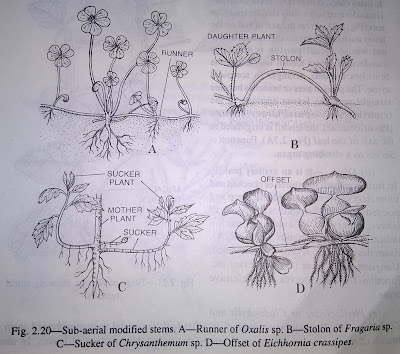The stem
Modification of Stems : In some cases instead of growing upwards, the
stem may grow underground. The stem undergoes modifications or metamorphosis and assumes different shapes to perform various functions other than the normal ones.
Functions of Underground Modified Stems :
(i) Perennation :-Survival through unfavourable conditions for many seasons.
(ii) Vegetative propagation :-New plants are formed from the vegetative parts.
(iii) Storage of food and water :-Food matters and water are stored within the underground stems.
Character of the Underground Stems differing from Roots :
(1)Presence of nodes and internodes.
(2) Presence of small dry, scale leaves and development of adventitious roots from the nodes.
(3) Presence of buds at the axils of scale leaves. (4) Internal structures are ‘like those of stems.
Types of Modified Underground Stems :
1. RHIZOME :--It is a thick, fleshy uhderground stem with distinct nodes and internodes, growing horizontally, sometimes more or less vertically beneath the surface of the soil. The presence of distinct brown scale leaves at the nodes with the axillary buds in most cases indicates the nature of the stem. From the lower surface of the nodes, a large number of adventitious roots are developed. Under favourable condition the terminal bud develops into aerial shoot. At the close of the vegetative season the annual parts die, leaving a scar on the upper surface of the rhizomes. The rhizome continues its growth by one or more lateral buds, thereby it grows year after year. It is found in herbaceous perennial monocotyledons e.g., Zingiber offiicinale (Zingiberaceae), Musa paradisiaca (Musaceae), Cumuma domestica (Zingiberaceae) etc.
 |
| Modified underground stems |
In some plants like Alocasia indica (Araceae), Nymphaea esculenta (Water-lily) of Nymphaeaceae, the rhizome grows in vertical direction instead of being horizontal. Those stout vertical rhizomes are called root-stock. When the rhizome is wiry, horizontal and has long intemodes, it is called a sobole. Common examples are some members of the family Gramineae viz., species of Agropyron, Spinifex littoreus, Cynodon dactylon etc. Some botanists consider sobole as underground runner or creepin g stem due to thin and wiry nature of the stem devoid of accumulated food matter.
2. STEM TUBER :-It is the swollen tip of an underground creeping branch which arises from the axil of a leaf on the main stem. Its further growth in length is retarded, the tip becomes swollen and enlarged owing to the deposit of food matters. The shape of the tuber is round or oval and it possess several irregular internodes. On the surface . of the tuber eyes are present. Scars of minute scale leaves which fall off very early are present-these bear normal buds in their axils. Adventitious buds are absent in the tuber. Examples of tuber are Solanum tuberosum (Potato-Solanaceae), Cyperus rotundus (Cyperaceae) etc.
 |
| Modified underground stems |
3. CORM :--It is an enlarged, more or less round, solid, vertical fleshy underground stem with a single internode with many adventitious buds and roots on the surface of its body. The scale (thin and membranous) leaves are few and often situated at the' apex encircling the petiole of the foliage leaf. Buds are present ; some of them develop into new young corms and the old corm ultimately dies. Adventitious roots grow either from all over the body or from the base of the com, e.g. Amorphophallus campanulatus (Araceae), Crocus sativus (Liliaceae) etc.
 |
| Modified underground stems |
4.BULB :-The bulb is a small, modified disc-like underground stem. The stem is extremely reduced and takes the shape of a disc. Thick and fleshy leaf bases are crowded in concentric manner one above the other over the discoid stem which bears numerous
fibrous adventitious roots at its base. Food materials are stored within the fleshy underground scale leaves. Axillary buds are present in the axil of leaf bases and also a terminal bud in the centre of the disc.
There are two kinds of bulbs :
(a) Tunicated bulb-Here fleshy leaf bases are arranged in a concentric manner and the scale leaves become dry, thin and membranous to form common covering or tunica, hence the bulb is known as tunicated bulb, e.g. Allium cepa (Liliaceae).
(b) Scaly or naked bulb-Here the thick and fleshy leaf bases are not arranged in a concentric manner, they overlap one another and are not covered by tunic (dry scale leaves),
e.g. Lilium candidum, Tulipa gesneriana (Liliaceae).
Sub-aerial Modified Stems : There are four types of sub-aerial modified stems for vegetative propagation, such as
( l) RUNNER-It is a slender, prostrate, creeping aerial stem or branch. After running a short distance over the earth in a creeping manner it sends off roots at its end and leaves develop, thus producing a new plant which produces another runner from its leaf-axil which behaves similarly ; thus a series of independent plants are linked together by several runners. Sometimes runner bears scale leaves, e.g. Centella asiatica (Umbelliferae), Oxalis corniculata (Oxalidaceae), Marsilea sp. (Pteridophyte) etc.
(2) OFFSET :-It is just like runner, but the stem is shorter and thicker. The branch produces at the ends cluster of roots and tuft of leaves e.g. Pistia stratiotes, Eichhornia crassipes (Pontederiaceae).
 |
| Sub-aerial modified stems |
(3) SUCKER :This is a sub-aerial branch arising from the stem below the surface of the earth and which after growing in a horizontal direction for certain distance produces roots and turns upwards above the ground ; ultimately it develops into a new plant e.g. Mentha spicata (Labiatae), Chrysanthemum coronarium (Compositae) etc.
(4) STOLON:--It is almost like a runner but the branch is more slender and longer, and arches due to its great length. On touching the soil the tip produces cluster of roots and leaves, e.g. Fragaria vesca (Rosaceae).
Function of Sub-aerial Modified Stem :
The function of sub-aerial modified stems in many cases is quick vegetative propagation, e.g. species of Pistia and Eichhonia (Water hyacinth).




This blog post provides valuable information about modified underground stems.
ReplyDelete